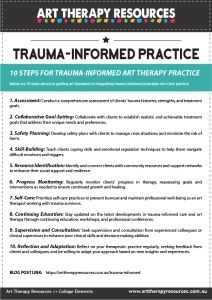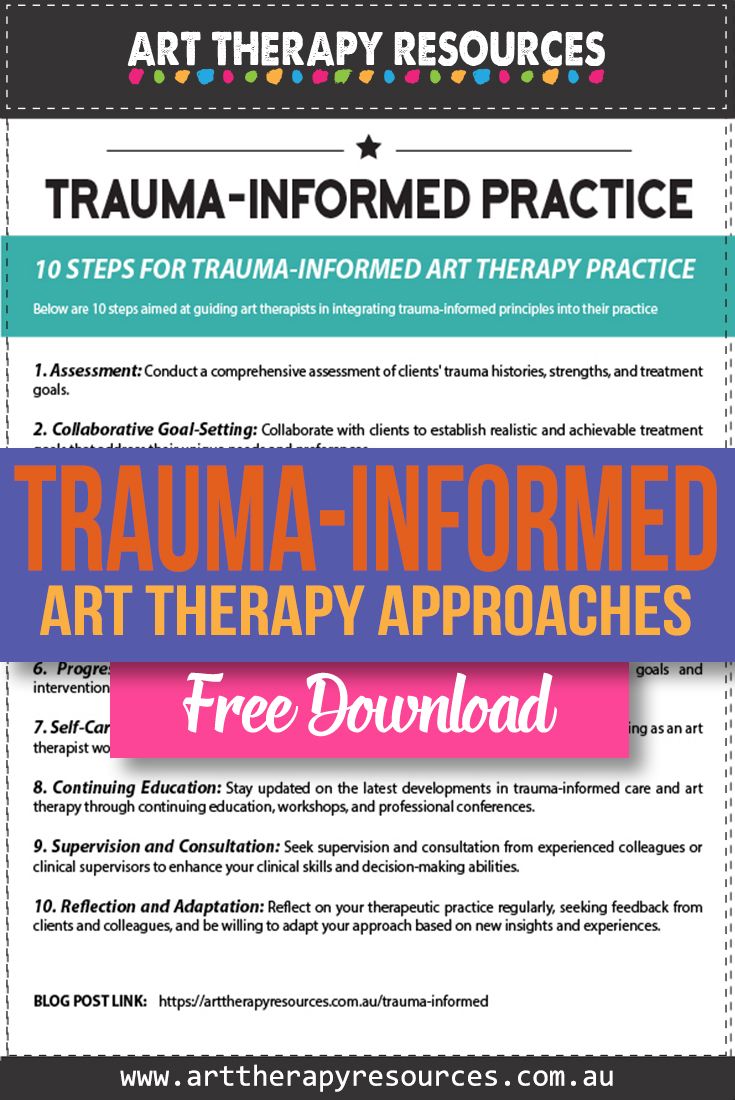THIS POST INCLUDES:
1. Types of business networks
2. Who is in your network
3. Using your Network
4. Free Download Business Contact List
A HOLISTIC APPROACH
Art therapy has significant benefits for individuals who have experienced trauma. A trauma-informed approach to art therapy acknowledges the impact of past experiences on mental and emotional well-being, emphasizing safety, validation, and compassionate support.
Trauma-informed art therapy represents a paradigm shift in how we approach working with individuals who have experienced trauma. This approach acknowledges its pervasive impact on every aspect of an individual’s life including cognitive distortions, emotional dysregulation, dysfunctional relationship dynamics, and altered perceptions of self.
Trauma-informed art therapy recognizes that healing must occur on multiple levels simultaneously. It’s not enough to address the surface symptoms of trauma; instead, therapists must delve deeper, exploring the underlying beliefs, emotions, and relational patterns that have been shaped by the experience of trauma.
This holistic approach to therapy emphasizes the interconnectedness of mind and body. It recognizes that trauma is stored not only in the brain but also in the body, manifesting as physical symptoms such as tension, pain, and somatic complaints. Through art therapy, clients can access these embodied experiences, using the creative process to explore and release stored trauma from their bodies.
Moreover, trauma-informed art therapy acknowledges the role of social and cultural factors in shaping individuals’ experiences of trauma. It recognizes that marginalized communities may face unique challenges and barriers to healing. As such, therapists must approach their work with cultural humility, acknowledging their own biases and strive to create a therapeutic environment that is inclusive and affirming for all clients.
At its core, trauma-informed art therapy is about creating a safe and supportive space where clients can explore their experiences, express their emotions, and begin the process of healing. It’s about empowering clients to reclaim their agency and rewrite their narratives by transforming their pain into resilience and strength. It’s also about fostering a sense of connection and belonging and reminding clients that they are not alone on their journey toward healing.
TECHNIQUES AND INTERVENTIONS
In trauma-informed art therapy, the techniques and interventions used focus on developing a safe and supportive environment for clients to explore their trauma and understand the impact that past experiences has on the client. One key aspect of this approach involves utilizing nonverbal expression through art as a primary means of communication. For many individuals who have experienced trauma, verbalizing their emotions and experiences can be challenging. By providing clients with the opportunity to express themselves through art, therapists offer a powerful alternative for processing and articulating complex emotions.
Symbolism is integral in trauma-informed art therapy as it encourages clients to explore the meaning behind their creations and how it reflects inner conflicts, thoughts, and emotions. Symbols serve as bridges between the conscious and unconscious mind and offer a visual language through which clients can convey their innermost thoughts, feelings, and memories. Through the exploration of symbolism, clients can uncover hidden aspects of their trauma and gain insight into their experiences.
Narrative processing is another component of trauma-informed art therapy that enables clients to construct cohesive narratives that reflect their lived experiences. Through the creation of visual narratives, clients can externalize their trauma and gain a sense of mastery over their stories. This process allows clients to reframe their experiences, reclaim agency, and rewrite the narrative of their trauma in a way that empowers them.
Grounding techniques are invaluable tools for regulating emotions and anchoring clients in the present moment during art therapy sessions. These techniques help clients feel safe and supported, reducing feelings of overwhelm and dysregulation. Mindfulness practices, sensory exploration, and deep breathing exercises are additonal examples of grounding techniques used to facilitate emotional regulation and stability.
Furthermore, trauma-informed art therapy emphasizes the importance of creating a therapeutic environment that is sensitive to the unique needs and experiences of each individual client. Therapists must approach their work with cultural humility, acknowledging the role that social and cultural factors play in shaping clients’ experiences of trauma. By creating a space that is inclusive, affirming, and culturally competent, therapists can ensure that all clients feel seen, heard, and valued in their healing journey.
Trauma-informed art therapy offers a holistic approach to healing that recognizes the interconnectedness of mind, body, and spirit. By integrating nonverbal expression, symbolism, narrative processing, and grounding techniques, therapists can create a safe and supportive space for clients to explore their trauma, express their emotions, and begin the process of healing and resilience-building.
NAVIGATING ETHICAL AND CULTURAL TERRAIN
In trauma-informed art therapy, practitioners often navigate ethical considerations and cultural differences to ensure the effectiveness and integrity of their practice. Ethical guidelines provide a framework for maintaining the safety, autonomy, and dignity of clients throughout the therapeutic process.
Central to trauma-informed practice is the principle of client autonomy, which emphasizes the importance of respecting clients’ rights to make informed decisions about their treatment. Art therapists must prioritize informed consent, ensuring that clients understand the nature of therapy, the goals, and potential risks involved, and have the autonomy to consent to or decline participation in therapeutic activities.
Confidentiality is another fundamental ethical principle that art therapists must uphold to foster trust and safety within the therapeutic relationship. Clients must feel confident that their personal information and artwork will be kept confidential. Art therapists must establish clear boundaries around confidentiality and communicate these boundaries effectively to clients from the outset of therapy.
Cultural competence is essential for providing effective and inclusive trauma-informed art therapy. Art therapists must be sensitive to the cultural norms, values, and beliefs of their clients and adapt their therapeutic approach accordingly. This includes recognizing and respecting cultural differences in communication styles, expressions of emotion, and attitudes towards mental health and help-seeking behaviour.
Moreover, trauma-informed art therapists must be aware of the potential for cultural biases and stereotypes to influence their perceptions and interactions with clients. Culturally responsive practice requires ongoing self-reflection and education to identify and challenge personal biases and assumptions and to create a therapeutic environment that is welcoming and affirming for clients from diverse cultural backgrounds.
In addition to ethical and cultural considerations, trauma-informed art therapists must also be mindful of the power dynamics inherent in the therapeutic relationship. It is essential to create a collaborative and empowering environment where clients feel respected, valued, and supported in their healing journey. Art therapists must strive to balance their role as experts with a recognition of clients’ expertise in their own experiences and narratives.
Ultimately, navigating the ethical and cultural terrain of trauma-informed art therapy requires a commitment to ongoing learning, reflection, and dialogue. By upholding ethical principles, fostering cultural competence, and centering the needs and experiences of clients, art therapists can create a therapeutic space that is safe, inclusive, and conducive to healing and growth.
ACTION PLAN: 10 STEPS
Developing a trauma-informed approach to art therapy practice is essential for effectively supporting clients who have experienced trauma. This section outlines 10 steps aimed at guiding art therapists in integrating trauma-informed principles into their practice. Each step is designed to promote safety, empowerment, and healing while fostering a collaborative and client-centered therapeutic environment.
As art therapists, our role extends beyond facilitating creative expression; we must also serve as advocates for our clients’ well-being, recognizing the impact of trauma on their lives and providing tailored interventions to support their healing journey. By implementing this action plan, art therapists can enhance their clinical skills, deepen their understanding of trauma, and cultivate a therapeutic space that promotes resilience and recovery.
Through a combination of assessment, goal-setting, skill-building, and ongoing reflection, art therapists can create a framework for trauma-informed practice that prioritizes the needs and experiences of their clients. This action plan serves as a roadmap for art therapists seeking to integrate trauma-informed principles into their work, fostering a culture of safety, empowerment, and healing within the therapeutic relationship.
By following these guidelines, art therapists can enhance their capacity to effectively support clients who have experienced trauma, fostering growth, resilience, and empowerment throughout the therapeutic process.
1. Assessment: Conduct a comprehensive assessment of clients’ trauma histories, strengths, and treatment goals.
2. Collaborative Goal-Setting: Collaborate with clients to establish realistic and achievable treatment goals that address their unique needs and preferences.
3. Safety Planning: Develop safety plans with clients to manage crisis situations and minimize the risk of harm.
4. Skill-Building: Teach clients coping skills and emotional regulation techniques to help them navigate difficult emotions and triggers.
5. Resource Identification: Identify and connect clients with community resources and support networks to enhance their social support and resilience.
6. Progress Monitoring: Regularly monitor clients’ progress in therapy, reassessing goals and interventions as needed to ensure continued growth and healing.
7. Self-Care: Prioritize self-care practices to prevent burnout and maintain professional well-being as an art therapist working with trauma survivors.
8. Continuing Education: Stay updated on the latest developments in trauma-informed care and art therapy through continuing education, workshops, and professional conferences.
9. Supervision and Consultation: Seek supervision and consultation from experienced colleagues or clinical supervisors to enhance your clinical skills and decision-making abilities.
10. Reflection and Adaptation: Reflect on your therapeutic practice regularly, seeking feedback from clients and colleagues, and be willing to adapt your approach based on new insights and experiences.
Trauma-informed art therapy requires a holistic understanding of trauma, cultural sensitivity, and evidence-based practice. By integrating trauma-informed principles into our work as art therapists, we can create a safe and supportive environment where clients can heal, grow, and reclaim their sense of agency and resilience.
FREE DOWNLOAD: Art Therapy Exercise
SIGN UP below to gain access to our RESOURCE LIBRARY and download the FREE recommended book list for trauma-informed practice.

BUILD YOUR ART THERAPY REFERENCE MATERIALS:
Pin this image to your Pinterest board.

SHARE KNOWLEDGE & PASS IT ON:
If you’ve enjoyed this post, please share it on Facebook, Twitter, Pinterest. Thank you!
